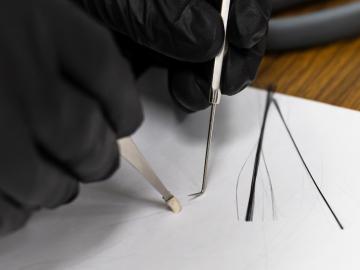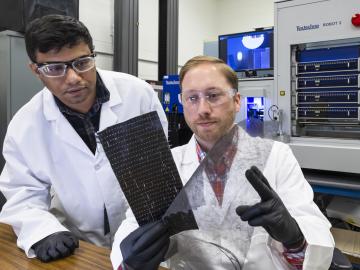
Filter News
Area of Research
- Advanced Manufacturing (3)
- Biological Systems (1)
- Biology and Environment (26)
- Computational Biology (2)
- Computational Engineering (1)
- Computer Science (2)
- Energy Science (33)
- Fuel Cycle Science and Technology (1)
- Fusion and Fission (27)
- Fusion Energy (10)
- Isotope Development and Production (1)
- Isotopes (27)
- Materials (54)
- Materials for Computing (8)
- National Security (25)
- Neutron Science (18)
- Nuclear Science and Technology (38)
- Nuclear Systems Modeling, Simulation and Validation (1)
- Quantum information Science (2)
- Supercomputing (56)
News Topics
- (-) Biomedical (73)
- (-) Cybersecurity (35)
- (-) Exascale Computing (67)
- (-) Isotopes (62)
- (-) Nuclear Energy (122)
- (-) Polymers (35)
- 3-D Printing/Advanced Manufacturing (147)
- Advanced Reactors (40)
- Artificial Intelligence (131)
- Big Data (79)
- Bioenergy (112)
- Biology (128)
- Biotechnology (39)
- Buildings (74)
- Chemical Sciences (86)
- Clean Water (33)
- Composites (35)
- Computer Science (226)
- Coronavirus (48)
- Critical Materials (29)
- Education (5)
- Element Discovery (1)
- Emergency (4)
- Energy Storage (114)
- Environment (218)
- Fossil Energy (8)
- Frontier (64)
- Fusion (67)
- Grid (74)
- High-Performance Computing (130)
- Hydropower (12)
- Irradiation (3)
- ITER (9)
- Machine Learning (68)
- Materials (157)
- Materials Science (158)
- Mathematics (12)
- Mercury (12)
- Microelectronics (4)
- Microscopy (56)
- Molten Salt (10)
- Nanotechnology (64)
- National Security (86)
- Neutron Science (171)
- Partnerships (68)
- Physics (69)
- Quantum Computing (53)
- Quantum Science (93)
- Security (31)
- Simulation (65)
- Software (1)
- Space Exploration (26)
- Statistics (4)
- Summit (71)
- Transportation (103)
Media Contacts

Stronger than steel and lighter than aluminum, carbon fiber is a staple in aerospace and high-performance vehicles — and now, scientists at ORNL have found a way to make it even stronger.

Researchers at ORNL have developed an innovative new technique using carbon nanofibers to enhance binding in carbon fiber and other fiber-reinforced polymer composites – an advance likely to improve structural materials for automobiles, airplanes and other applications that require lightweight and strong materials.

Analyzing massive datasets from nuclear physics experiments can take hours or days to process, but researchers are working to radically reduce that time to mere seconds using special software being developed at the Department of Energy’s Lawrence Berkeley and Oak Ridge national laboratories.

Scientists at ORNL have developed a vacuum-assisted extrusion method that reduces internal porosity by up to 75% in large-scale 3D-printed polymer parts. This new technique addresses the critical issue of porosity in large-scale prints but also paves the way for stronger composites.

Jesse Labbé aims to leverage biology, computation and engineering to address societal challenges related to energy, national security and health, while enhancing U.S. competitiveness. Labbé emphasizes the importance of translating groundbreaking research into practical applications that have real-world impact.

ORNL researchers helped introduce college students to quantum computing for the first time during the 2025 Winter Classic Invitational, providing hands-on access to real quantum hardware and training future high-performance computing users through a unique challenge that bridged classical and quantum technologies.

Scientists at the Department of Energy’s Oak Ridge National Laboratory recently welcomed Vanderbilt University colleagues for a symposium on basic science research, with a focus on potential collaborations in the biomedical and biotechnology spaces.

The Innovative and Novel Computational Impact on Theory and Experiment, or INCITE, program has announced the 2026 Call for Proposals, inviting researchers to apply for access to some of the world’s most powerful high-performance computing systems.
Daniel Jacobson, distinguished research scientist in the Biosciences Division at ORNL, has been elected a Fellow of the American Institute for Medical and Biological Engineering, or AIMBE, for his achievements in computational biology.

A team from ORNL, joined by university students, recently traveled to the Ohio State University Research Reactor to conduct a novel experiment on nuclear thermal rocket fuel coatings — one that could help propel NASA’s astronauts to Mars faster and more efficiently.


